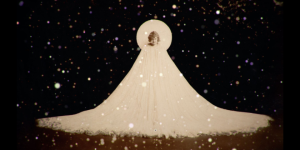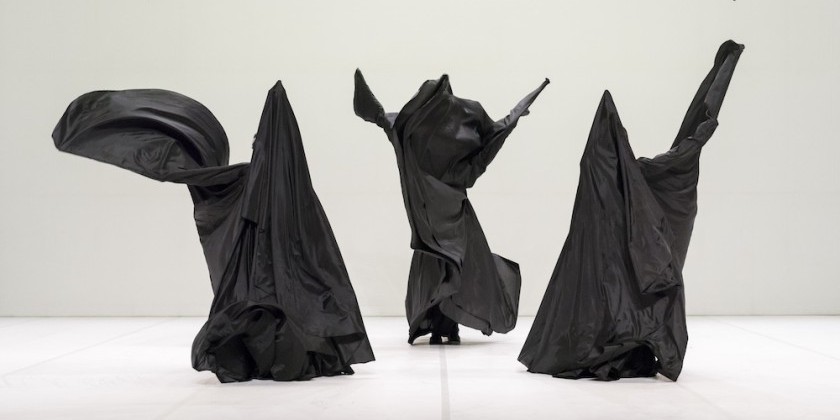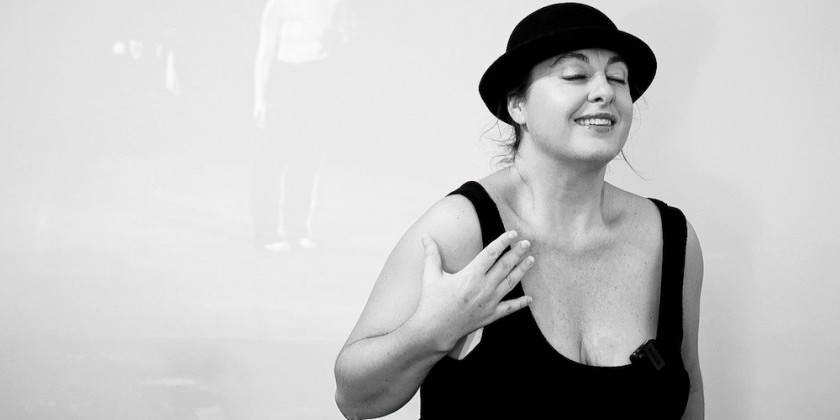THE DANCE ENTHUSIAST ASKS: Jody Sperling on 'Ecokinetics,' The Power of Art, and Dancing for Mother Earth

Expanding the Legacy of Loie Fuller
"To see the world in a grain of sand ; And heaven in a wild flower; To hold infinity in the palm of your hand; And eternity in an hour."
William Blake wrote those lines in 1803, but they could describe the vision of New York choreographer Jody Sperling today. She calls her company Time Lapse Dance, after a film device that radically compresses time. And her current goal is to squeeze the cosmos down to human scale, to show what is happening to Mother Earth.
A century after Loie Fuller extended dance into space with a fantastic apparatus of poles and fabrics, Sperling has picked up Fuller’s mantle, creating new costumes and choreography that turn dancers into trees, winds, starscapes, sea ice, etc. etc. She calls it 'ecokinetics' — a dance practice exploring the relationship between human movers and ecological systems. Coming out of Covid, Time Lapse Dance has re-assembled for a dizzying round of performances in April and May — around Earth Day. We caught Jody on a rehearsal break onstage at The New York Society for Ethical Culture.
Tom Phillips for The Dance Enthusiast: I’m always excited to learn a new word, and the latest is 'ecokinetics.' Did you make that up?
Jody Sperling: Yes! (laughs). I made it up to describe what I was already doing. Ecokinetics is a corollary to ecoacoustics, a genre of music that my collaborator Matthew Burtner has been instrumental in developing. Ecoacoustics gathers sounds from the natural environment and then uses technologies—such as filtering these sounds through different harmonic systems — to make music.
Ice Cycle choreographed by Jody Sperling; photo by Phyllis McCabe
So I asked: how could I as a dancer go into an environment — and listen, observe, sense what is happening, and then reflect, reproduce with my body what’s going on? How could I create choreographic patterns that amplify, for example, what’s going on in the Arctic ice?
When I went to the Arctic I looked around at the horizon, and the atmosphere, and felt the sensation of being on the ice. Then I learned the science of it, the formation of Arctic ice. It’s porous, and it has these brine channels, and waves. I collected data and made a composition out of it. But it’s more than just data, it’s the sensory and tactile experience of the icescape.
That project resulted in a film of me dancing on sea-ice, in which I showed a kind of time-lapse of ice dynamics. A time-lapse helps you see the shape of change. It reveals the forces present. So time-lapse is a tool of ecokinetics.
Jody Sperling dancing on the frozen Chukchi Sea wearing a costume by Mary Jo Mecca with textile painting by Gina Nagy Burns; photo by Pierre Coupel
Back in New York, Ice Cycle was me transporting the physics of ice formation and dissolution to the stage. Ecokinetics can translate those patterns — through the body and the Loie Fuller costume — onto the stage, or another environment such as a streetscape.
With Wind Rose, I was interested in how the winds are changing — and can we sense climate change just based on the craziness of the winds. A 'wind rose' is a graphic representation of wind speed, direction and variability at a particular time and place. It’s an actual thing in meteorology. And you can pull up wind roses for all the places where weather data is collected for over a hundred years.
So we created a wind rose on stage. In the opening sequence the dancers stand shoulder to shoulder. They start to move around like a turbine, and as they speed up, if you’re sitting in the audience you feel a kind of slap from the wind.

My favorite section of that piece is where we work with the connection between breath and atmosphere. When you try to draw a line where the person ends and the environment begins, there is no line. The breath goes right into the room, and the room goes into the atmosphere. And people talk about wind as being the breath of the planet. So I created this sequence of eight movements where each one has either a breath or a sound created by the fabric moving the air. I wrote them down on post-its and sent them to Matthew, and he created a fugue for these movements. And that became the score for this part of the dance.
You also talk about Time Lapse as a style of dancing. What is it, and what went into it?
I grew up with a foundation of ballet, and jazz, and different kinds of modern and post-modern dance, and contact improv, rolling on the floor, before I discovered Loie Fuller. But Loie Fuller, for me, is about this sense of expansion — understanding that your body resonates beyond its physical form. If you can learn how to harness those impacts you have on space, you can generate a lot of energy in a room.
One of the techniques I use is fractal patterning. Fractals are patterns in the body that are realized at different scales. You overlay the detail of the fingers curling and uncurling with the body curling and uncurling. All nature has fractal patterning. When you are trying to mirror, eco-reflect, illuminate patterns you see in nature, you can understand those fractal patterns in your own body, and reproduce that choreographically.
One of the patterns in your choreography is continuous spinning and whirling.
The Loie Fuller apparatus kind of drove me into spinning. One of my pieces, Northern Sky, is one continuous whirl. What’s powerful about spinning is that it shows you how stillness is an illusion. We are not sitting here still, we are on an earth that is hurtling through space, it is orbiting around the sun and our galaxy is moving. But the most wonderful thing is, when I am most into the piece, I am still – I find the stillness in movement. You can find stillness even in chaos. You can find peace even in a war zone.
We’re talking about politics now, art with a political purpose. You want to reach all the way to the people who hold the levers of power. But you’re not likely to see Joe Biden or Vladimir Putin in your audience. So how does art speak truth to power, how does it get through?
I think people often underestimate the power art has to shape our perceptions. Art has the power to move people in a way that hearing about legislative policy does not. In terms of climate – we are in a series of unfolding multiple crises, and people are confused about what to pay attention to – the war in Ukraine, refugees from Afghanistan, Covid, our vast racial inequities. But it’s all connected. Climate is a common thread. You can see the geopolitics of oil is a big part of this war. If we could transition to completely renewable energy sources – Putin would lose his power!

Awakening climate consciousness is critical. A lot of people are fearful, and they cannot act. You have to give them a lifeline, and one important thing is positive visioning. If you can imagine a tree growing on Amsterdam Avenue, it’s an acknowledgement that trees once grew there, and there were people who lived in harmony with those trees, and we can learn from how they lived. And we can plant trees there again.
People need to feel this supreme grief for what is, because everything needs to change. But if you can work through that grief, and see the world that we need to conjure, to summon – and art can help guide us toward what that world is — then they are more empowered to act.
We are in the midst of a climate awakening. People are talking about it. And it’s very important that we talk about it with this active visioning, and get through that place of fear. We always try to pair our programs with some kind of discussion, so people can begin to work through and find their pathways.

Jody Sperling at the site of a collaborative project (with Amy-Claire Huestis and Omar Zubair), namely the Roberts Bank Key Bird Area, Fraser River Delta, British Columbia. There are plans to expand the Roberts Bank Terminal container port in the background, which would threaten the critical bird migration habitat.
What’s coming up for Time Lapse Dance?
We are performing on stage for the first time since 2020. Our season at the 14th Street Y is May 5 through 7. We’ll also be at the Mandell Theater in Philadelphia April 29, bringing back Ice Cycle and Wind Rose. And Matthew Burtner is coming to New York and Philadelphia to perform the music live.
I’m also starting a new partnership here at The New York Society for Ethical Culture, which has a deep commitment to ecological justice. We have a residency leading up to our May performances. And we’re already envisioning large-scale programming around Earth Day 2023.
It’s going to be epic!












